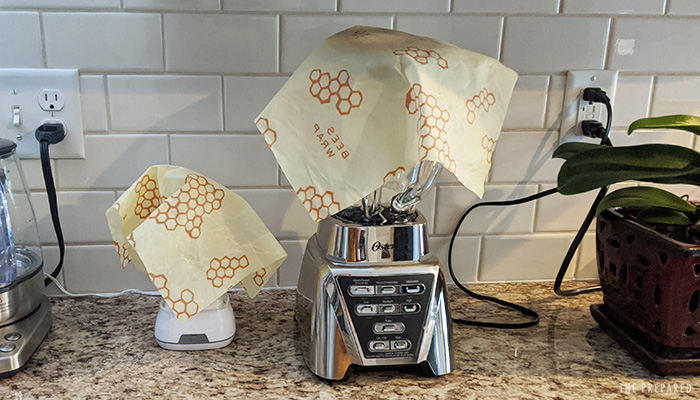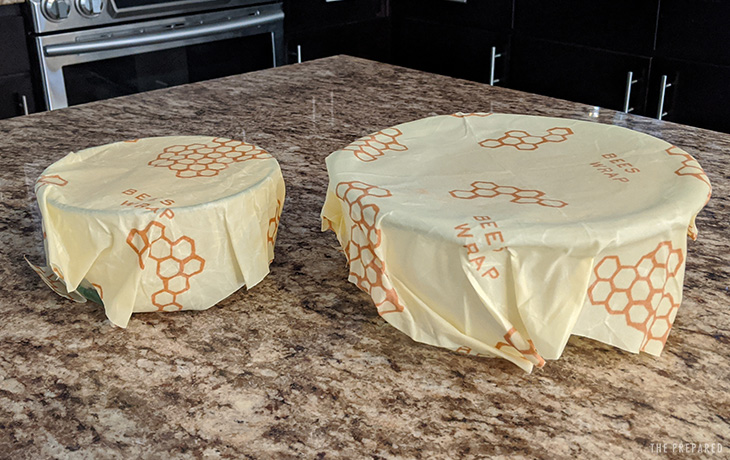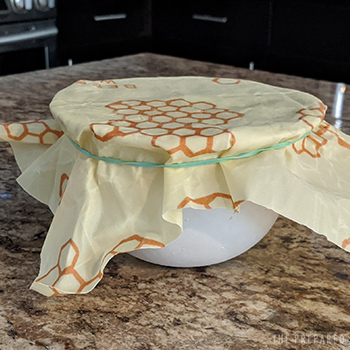For the past two years I’ve been wondering if beeswax wraps were worth adding to my home preps. They’re reusable and environmentally friendly, which made me wonder if they lasted long and performed well enough to be a prepper’s alternative to standard cling wrap for food preservation. Instead of single-use plastic, beeswax wraps are pieces of cotton fabric with a coating of natural wax, oil, and resin.
Since one of the weird things experiencing a shortage during COVID is cling wrap, it felt like the right time to try, so I personally bought two wraps from Bee’s Wrap and tested them over two months for this review.
Beeswax wraps are not a proprietary product from Bee’s Wrap. You can find beeswax wraps from a lot of other sellers, like Trader Joe’s or Public Goods. There’s an almost infinite choice of beeswax wraps on Etsy or Amazon. There are also various DIY instructions online out there — even vegan ones!
Although this review is about the offering from Bee’s Wrap, I feel comfortable extending the conclusions to the whole category. One reason is that the composition of beeswax wraps appears to be similar across the board (wax, resins, and oils). Another is that our judgement of whether or not they’re good for prepping has more to do with the big picture than any specific details between one product to the other. We had no specific reason for testing Bee’s Wrap instead of another brand — just a game of chance!
Summary:
- Although they performed fine, in the end I felt that beeswax wraps don’t really serve a prepping role.
- They’re a good purchase if you’re looking for ways to cut down on plastic use during normal life.
- The wraps stored food well and kept smells and moisture where they should (and shouldn’t) be.
- They could have a role in your preps if you like to wrap up perishable food and don’t want to run the risk of not being able to get cling wrap.
- The coating breaks down from heat and use — I estimate about a year of normal usage. Even a representative from Bee’s Wrap couldn’t give us an expected lifespan.
- You can’t expose the wrap to heat because it will melt the coating.
- They clean easily, although you wash them with cold water and that might leave behind some contamination.
- You shouldn’t put raw meat in these wraps because you won’t be able to thoroughly clean all of the surface.
What are beeswax wraps?
Bee’s Wrap beeswax wraps are pieces of cotton fabric soaked in a mixture of beeswax, jojoba oil (other brands might use coconut oil instead of jojoba), and pine resins. The oils and waxes create a waterproof fabric that can be molded with just the heat of your hands and can be wrapped around food or containers.
Beeswax is naturally antibacterial, which keeps food fresh and reduces the risks of contamination, although it might not totally prevent cross-contamination.
Bee’s Wrap offers different wrap sizes, from a small 7” x 8” square, to an extra large roll measuring 14” x 52”, as well as 13” x 13” sandwich wraps with a tie. I bought a large 13” x 14”, and a medium 9.5” x 10.5”. (The closest size Bee’s Wrap now offers is the medium 10” x 11”.)
At $6 per square foot, they are also noticeably more expensive than saran wrap, cellophane, cling film, or the equivalent plastic wraps on the market.
How long does a beeswax wrap last?
Beeswax wraps last for up to a year depending on how often you use them and wash them. You’ll know your wrap has reached the end of its life when it has worn thin and soft and has trouble sticking to itself.
Before it completely loses its stickiness, you can try and revive the wrap every few months by either putting it in a baking tray in the sun for a few hours, holding it up and warming it with a hairdryer, or ironing it in between baking paper.
When it has completely lost its stickiness, the wrap can be cut into strips and composted, or, better still, used as a fire starter.
But how long exactly does it last? When I reached out to Bee’s Wrap for clarification, a representative simply said, “When used and stored properly (kept away from heat and/or storage in warm climates without temperature controls), our products have a long shelf life.”
When pressed for more details, their rep added, “We have many wraps from the early days [2012] still in rotation that work beautifully. Beeswax itself doesn’t have an expiration date, and is a natural preservative.”
So it’s fair to assume that when stored correctly, beeswax wraps might last a long time, but we don’t know how long. Beeswax needs to be stored between 64 °F (18 °C ) and 148 °F (64.5 °C ).
How do you clean it? Is it safe to reuse?
Because of beeswax’s sensitivity to heat, the wraps can only be cleaned with cold or lukewarm water. Bee’s Wrap recommends cleaning their wraps by brushing them lightly with cold water and detergent.
In terms of safety, there’s enough evidence that beeswax (and other bee products too, such as honey) is truly antibacterial and it inhibits the growth of bacteria. However, there is also evidence that handwashing in cold water alone does not clean the wraps satisfactorily.
Dishwashing kills bacteria more effectively at higher temperatures. As water temperature increases, bacteria starts to die off. Unfortunately, washing the wraps with hot water would ruin them. The wax would start to soften up and you’d risk brushing that soft wax off, basically accelerating their expiration date.
So beeswax wraps are safe to reuse but they’re not 100% effective at shielding you and your family from contamination from old food or raw meat.

Testing the Bee’s Wraps
When testing the wraps I actually realized that I don’t use cling wrap all that often anymore. I mostly use tupperware or Ziploc bags. I also tend to reuse Ziploc bags by washing them.
In the two months since I bought the wraps, I’ve used them to wrap a:
- cut watermelon
- cut raw onion
- leftover sandwich
- paper bowl
- cheese
By testing the wraps I was mainly interested in finding out how they compare to plastic wrap in terms of clinginess and wrappabilty, how easily they are to clean, and if the wax and oils transfer onto the food being wrapped. Of course I knew that I was in no position to conduct microbiological tests myself so, to test their cleanliness after washing them, I basically just checked if they looked and felt clean with no visible food residue or if they still smelled of the food that they covered.
The watermelon: This was the easy one. I used the medium wrap which wrapped tightly around the whole of the cut side. The watermelon lasted a couple of days before it was eaten, and it was stored in the fridge. The cut surface never looked dry and, to my surprise, no taste of beeswax. The wrap cleaned nicely, with no visible residue — after all, a watermelon is really just sugar, right?
The onion: After the success with the watermelon I picked up my courage and wrapped a quarter of a raw onion with the small wrap. If you’ve ever left a raw onion open in the fridge you know what I feared most — a very stinky fridge, a dried out onion, and, somehow, an onion that smelled of every other food in the fridge.
Surprisingly, after I used the Bee’s Wrap, the fridge did not smell of onion a bit! I left it in the fridge for about four days, and when I unwrapped it, it looked as fresh as ever.
Now, the moment of truth: would the wrap still smell of onion? No, it didn’t! This really amazed me. Could beeswax be magic?
The sandwich: I sacrificed a half a cubano left from lunch, wrapped it with the medium wrap, and left in the fridge for 24 hours. The next day, the sandwich didn’t look dry at all. I don’t know if it was because of the wrap’s magic properties or because the sandwich contained moist meat and vegetables. But it didn’t become soggy, either.
The wrap cleaned seemingly well, but the part in contact with the al pastor meat is still stained. I’m wondering if that’s the result of the wrap being porous combined with the oils in the meat emulsifying with the oils and waxes in the wrap. Probably not a great idea to wrap oily foods with it.
A paper bowl: Before you think, “Que?” let me explain. The paper bowl was from a frozen meal and it was that kind of very porous compostable paper. As you can imagine, not even plastic wrap sticks well to paper and the beeswax wrap didn’t behave any differently. I just covered the bowl with the medium wrap the best I could and then I secured it up with an elastic band. Easy.
In this case, the wrap didn’t touch the food so the wrap was basically still clean after a day. Although there was a gap left between the wrap and the food, the food didn’t really dry out either.
The cheese: I’m European so I love me some smelly cheeses, but, alas! I didn’t have any of the sort around for this test. So, just for the sake of giving it a try, I lazily wrapped a piece of a mozzarella stick with the small wrap. I just wanted to see if the cheese would get too dry, taste of wax, or if I would need to throw the wrap away after use. I left the mozzarella in the fridge for a couple of days.
By the time I retrieved it, the cheese was just the slightest bit dry, but nothing gross. And, predictably, no taste of wax, and no smell of cheese left after washing the wrap!
Test results
Generally, the wraps performed well. I would have used them for a couple of other trials but I didn’t have the right size handy.
I was pleasantly surprised that there was no odor transfer, neither from the wraps to the food, or vice versa.
Cleaning them was easy enough. I wet them, placed them on the counter next to the sink, brush them with a dishwashing brush, and then let them dry draped on top of other kitchenware.
None of the food I wrapped in wax dried out or rotted more than expected. In this regard, I actually think the beeswax wraps are better than plastic wrap. The wraps are allegedly breathable, so maybe that’s why they don’t dry food or make it sweat and rot.
Are beeswax wraps worth it?
For their intended use (as a reusable substitute to plastic wrap) they work well enough. Although they don’t stretch like plastic wrap does, beeswax wraps cling to all the smooth surfaces that plastic wrap clings to. The beeswax also wraps nicely around various foods.
Unlike plastic wrap, with beeswax wrap, you’re limited to the sizing of the wrap itself. Most wraps are pre-cut, but Bee’s Wrap offers a 14″ x 52″ roll that you can trim to your desired size.
Another main difference: while plastic wrap can be stored indefinitely and almost anywhere, beeswax wrap needs to be stored in a cool place. You wouldn’t want to leave it under the sun or in the heat, in case the wax melts or ruins anything underneath it. It also cannot be microwaved for the same reasons.
The cost factor
Put simply, beeswax wraps are just more expensive than plastic wrap. However, beeswax wraps can be reused, while plastic wrap is single use. So the question of whether the cost is worth it probably depends on how often you use plastic wrap, and how much you use at a time. If you use plastic wrap for cold storage every day, beeswax wrap might be worth the initial investment.
Since I mostly use tupperwares and ziploc bags for storage, I probably use no more than one roll of plastic wrap a year, if that.
For comparison, a 200 square foot roll of Glad Cling Wrap costs $3.99 at my local grocery store (that’s about $0.02/sq. ft.), while the XXL roll of Bee’s Wrap costs $30 for 5 sq. ft. (that’s $6/sq. ft.).
Beeswax wrap also can’t replace plastic wrap in every way, so you might still have to buy a roll of plastic wrap for reheating food in the microwave or for wrapping raw meat and fish.
The cost question is a little hard to answer because it’s unclear how long beeswax wrap is supposed to last. I’ve had my beeswax wraps for just a few months, and I’ve only used them a few times. But I can already feel them getting softer. The wraps are definitely not at a point where I think they will need to be ‘refreshed’ or even thrown away, but I can feel that they’re just slightly used.
At some unknown point, I know they’ll need to be composted or repurposed, but it’s frustrating to not know when that will be. And it makes planning and preparing much harder.
The final verdict
So are beeswax wraps worth considering as a good long-term prep, or are they just good for daily use? Here is what I think.
PRO
- Reusable.
- Compostable, or can be used as tinder once they expire.
- Works almost as well as plastic wrap.
- Good for cutting down on plastic wrap usage and as a back up.
- Bee’s Wrap is a B Corp and Green America certified company, and the wraps are made in the USA.
- Bee’s Wrap uses ethically sourced ingredients.
CON
- They only last about 1 year of careful usage.
- They have a finite dimension and cannot be cut to fit as well as cling wrap.
- Sensitive to heat, so they cannot be microwaved and cannot be cleaned with hot water.
- Cannot be used with raw meat or fish.
- Unclear if they can be a potential sanitary hazard.
- Unclear how long they can be safely stored for, and they need extra care to be stored in a cool (but not too cold) place.
- Noticeably more expensive than cling wrap ($0.02/sq. ft. vs $6/sq. ft.).
The bottom line: beeswax wraps are just too finicky to keep some of them in storage for my future long-term prepper needs. Since the wax needs to be stored at a certain temperature, has a finite shelf life, and is more expensive than plastic wrap, I’d rather just keep rolls of plastic wrap stored in my prepping supplies.
But these wraps are fine to use on day-to-day if you want to reduce plastic usage, or if, in times like these, you are afraid of lockdown shortages or want to reduce your trips to the grocery store in case you run out of plastic wrap (although you could probably substitute with aluminum foil or ziplock bags).
Personally, I have not experienced plastic wrap shortages (yet) but I am happy to have tried the wraps because I like to use less disposable plastic on an everyday basis.
Taking everything into account, I don’t feel the need to expand my stash of beeswax wraps any time soon. I’ll be sticking to the one small and one medium I already have for the time being, but I will use them instead of plastic wrap when I can.



You are reporting the comment """ by on